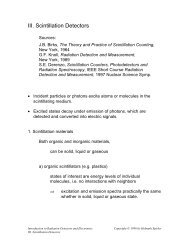VIII.2. A Semiconductor Device Primer
VIII.2. A Semiconductor Device Primer
VIII.2. A Semiconductor Device Primer
You also want an ePaper? Increase the reach of your titles
YUMPU automatically turns print PDFs into web optimized ePapers that Google loves.
With these simplifications the number of electrons in the conduction<br />
band in thermal equilibrium is<br />
or<br />
where Nc is the effective density of states at the band edge.<br />
Correspondingly, the hole concentration<br />
In a pure semiconductor<br />
where ni is the number of electrons or holes intrinsic to a pure<br />
semiconductor, i.e. where only source of mobile carriers is thermal<br />
excitation across the band gap without any additional impurity atoms<br />
or crystal imperfections that would allow other excitation<br />
mechanisms.<br />
Silicon (Eg = 1.12 eV): ni= 1.45 . 10 10 cm -3 at 300K<br />
Germanium (Eg = 0.66 eV): ni= 2.4 . 10 13 cm -3 at 300K<br />
For comparison:<br />
n<br />
n<br />
e<br />
e<br />
∝ ( k<br />
=<br />
p =<br />
N<br />
N<br />
c<br />
B<br />
v<br />
T )<br />
e<br />
3/<br />
2<br />
e<br />
−(<br />
E −E<br />
) / k T<br />
e<br />
c<br />
−(<br />
E<br />
n =<br />
p =<br />
F<br />
ni<br />
−(<br />
E −E<br />
) / k T<br />
The purest semiconductor material that has been fabricated<br />
is Ge with active impurity levels of about 3 . 10 10 cm -3 .<br />
F<br />
Introduction to Radiation Detectors and Electronics Copyright © 1998 by Helmuth Spieler<br />
<strong>VIII.2.</strong>a. A <strong>Semiconductor</strong> <strong>Device</strong> <strong>Primer</strong>, Doping and Diodes<br />
c<br />
B<br />
−E<br />
) / k T<br />
v<br />
B<br />
F<br />
B





